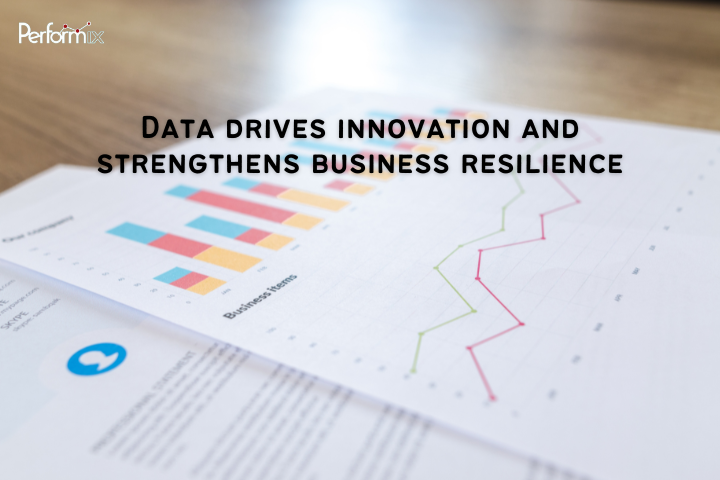Data-Driven Era
The Economic Impact of Data Innovation 2023, a global study report by Splunk Inc., estimates the monetary benefits of established data practices. The study found that businesses with access to more and better data saw a 9.5% gain in earnings, a 2.9x increase in the likelihood that they would beat the competition to market, and a 2.0x rise in the probability that they would meet financial projections.
In today’s world, data can be found anywhere and is continually being produced by corporations and individuals alike. As a business grows, its data goes from being a problem with its IT infrastructure to a limitless source of useful insights and information that gives it an edge in the market.
Almost every business today faces intense pressure to keep up with the exponential growth of data. However, the most stressed-out companies are also the most successful: While only 41% of intermediates and 15% of beginners report feeling the pressure, 67% of leaders in data innovation do.
The report’s findings will serve as a roadmap for your data-driven innovation (DDI), which will be the focus of this article.
Insights into the Data Innovation’s Economic Effects in 2023
In May and June of 2022, 2,000 IT, security, and business leaders from the United States, the United Kingdom, New Zealand, Australia, Singapore, Japan, France, Germany, and India participated in this global study on data practices. According to the survey, leading companies have excelled in all six of the most important aspects of data management: classification, aggregation, quality, analysis skills, tools, and monitoring.
The key findings of this survey include the following:
Profits and innovation are increasing for data leaders
Data leaders report introducing nine new goods each year that would only be conceivable with their data innovation capabilities, as opposed to beginners’ average of three new products per year, with an average gain of 9.5% in gross revenues. Additionally, they are more likely to report (49 percent versus 30 percent of beginners) that using data innovation in sales, marketing, and customer service/support has helped to increase customer lifetime value. Additionally, data leaders are 11% more robust and able to detect and address security breaches quickly.
Data leaders outperformed their rivals
Data leaders are 5.7 times more likely to claim that their company consistently makes better decisions than rivals. They are 4.5 times more likely to think their company is well-positioned to compete with other businesses in its market during the next years.
Data leaders are taking the initiative to operationalize and monetize their data
They have 2.3 times as much money coming from data monetization while also operationalizing 38% more of their data assets. Additionally, leaders are more likely to claim that their data monetization sources are complementary and will expand more quickly.
Experience with customers and upselling
According to our responses, a leader will be more successful at upselling due to the different price structures and conversion rates mentioned above if a data innovation leader and a novice both attract 50,000 new customers to a base offering of $200/year. A $10.7M gain over three years is the result.

What It Takes to Lead Data Innovation
Here are important suggestions to strengthen resilience and take opportunities.
1. Prioritize data innovation
Leaders take this matter of the value of data very seriously. Sixty percent of respondents cite greater data discovery and utilization as their top business and IT priority for the next two years.
2. Invest in your success
According to the adage, “you have to spend money to make money,” developing an innovation engine demands an initial investment. Leaders in data innovation dedicate an average of 20% of their technology budgets to solutions and personnel for data inquiry, monitoring, and analysis.
Moreover, leaders invest in a unified platform strategy rather than only point solutions. 92% of CEOs prioritize a platform strategy, pursuing technologies that function across data silos, include numerous sources, and span on-premises and cloud environments.
Executives are adopting new technologies that help their data innovation activities. Cloud analytics, AI/ML, edge computing, and observability are in various stages of accelerated adoption. The huge and still-growing potential of machine learning stands in contrast to how quickly edge and observability solutions, especially among leaders, are being used.
3. Promote innovation throughout the executive ranks
Data innovation leaders ensure that new thought is reflected at the highest organizational levels. Over 90% of leaders have positions at the C-level in customer success, data governance, data strategy, and innovation.
Intriguingly, staffing difficulties are more difficult for leaders because they are tasked with filling more specialized positions in a limited market for highly trained personnel. These challenges include finding candidates with the right skills, hiring those candidates once they are discovered, and keeping those employees once they are hired. Leaders were also more likely to say that, because of their goals for data innovation, data cleaning and preparation skills, AI/ML, and data visualization have become more in demand. But, of course, the returns are correspondingly higher.
4. Establish an excellence center
The most successful organizations progress data efforts with centralized rather than dispersed teams: 57% of leaders said they always rely on COEs, compared to 33% of intermediate organizations and 15% of novice organizations.
When comparing those who “always” use a COE to those who “always or usually” use one, the difference narrows to 76% of leaders, 63% of intermediates, and 60% of beginners. The leaders’ advantage may lie in their devotion to the centralized strategy.
5. Prioritize technology-centric data streams immediately
Leaders were more likely to choose technologically-oriented data when asked which sources had most recently inspired their innovation.
Here are the priorities,
Leaders:
1. Network data (cited by 30%)
2. Application data (28%)
3. Business service transaction/performance data (28%)
4. Customer data (27%)
5. Financial data (26%)
Beginners:
6. Customer data (cited by 36%)
7. Sales data (30%)
8. Operational tech/machine data 24%)
9. Network data (22%)
10. Sensor/IoT data (18%)
6. Switch to “know your customer” data
The executives’ emphasis on network and operational data does not imply that they need to be aware of customer-centric data’s importance. Leaders were more likely than beginners to indicate that sales data, customer data, and business service transaction and performance data have the most potential in the future. Leaders appear preoccupied with constructing the infrastructure necessary to use these human-centric facts.
7. Choose product innovation speed or success
Beginner and intermediate firms are more likely to claim that they strike a balance between innovating at breakneck speed and evaluating the market reception of their inventions. Leaders favored either speed or well-researched market appropriateness, as opposed to this split approach.
Intriguingly, leaders are evenly split between the two techniques, showing that both approaches are effective (depending on the nature of one’s industry, of course). It is preferable to succeed at something than to be average at everything.
8. Cultivate a larger sense of paranoia
The maturation of data improves organizational resilience. If you know everything about your infrastructure and business performance, it is easier to deal with technical problems, security threats, and changes in the market. Leaders are more likely than innovative competitors to predict that data will fundamentally disrupt their industry. Leaders are more confident that new data will enable companies to compete in areas they have yet to enter. This, despite their elevated paranoia, suggests that alertness is the price of leadership.
The creation and utilization of massive data sets are altering human “intelligence” capability and the social and economic landscapes, spawning new companies, processes, and products and providing major competitive advantages. Data-driven innovation (DDI) has become a key part of growth in the 21st century because it can improve productivity, resource efficiency, economic competitiveness, and social well-being.







